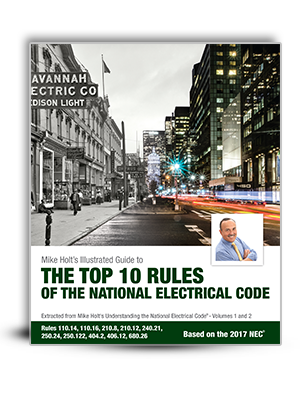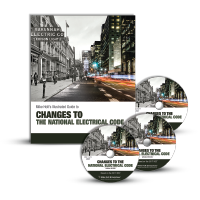|
When a new Code is adopted it often takes time to become familiar with all of the changes and how they impact the work in the field. I have spent my career working on making this process as easy as possible, and often I create FREE tools to help.
|

When a new Code is adopted it often takes time to become familiar with all of the changes and how they impact the work in the field. I have spent my career working on making this process as easy as possible, and often I create FREE tools to help. I would like to share two FREE resources that I know can help deepen your understanding of the 2017 NEC.
- Top 10 Rules. My review of the Top 10 Changes to the 2017 NEC is a great PDF to help introduce you to the 2017 Changes, with our signature graphics and easy-to-understand text. This PDF is a sample that was extracted from my textbook Mike Holt's Illustrated Guide to the 2017 NEC Changes. Download the PDF here.
- Most Important Changes. I would also like to share with you a list that we have compiled of changes that I consider to be some of the most important ones that were incorporated into the 2017 National Electrical Code. Download the List of Important Changes here.
Following is a list of the most important changes; they are a great tool to use with your copy of the 2017 NEC:
Article 100 Definitions
1. Accessible, Readily. This definition was editorially revised; the language about whom access is requisite was removed, and a clarification about the use of keys to gain access clarified.
Article 110 General Requirements
2. 110.3 Examination, Identification, Installation, Use, and Listing of Equipment. Changes to this section of the Code include addressing reconditioned, refurbished, or remanufactured equipment and providing rules for who may list electrical equipment.
3. 110.14 Conductor Termination and Splicing. A properly calibrated tool must be used when torqueing terminal connections.
4. 110.24 Available Fault Current. The available fault current calculation required by this section must now be made available upon request.
Article 210 Branch Circuits
5. 210.8 GFCI Protection. New information note added, the distances used for determining GFCI requirements are now addressed, some three-phase circuits now require protection, and new requirements for crawl spaces have been added.
6. 210.12 Arc-Fault Circuit-Interrupter Protection. The AFCI requirements have been greatly expanded.
7. 210.64 Electrical Service Areas. The rule requiring a convenience receptacle near the service disconnect was revised.
8. 210.71 Meeting Rooms. New rules require receptacle outlets for meeting rooms in commercial occupancies.
Article 215 Feeder Circuits
9. 215.2 Minimum Rating. A new rule clarifies the application of smaller feeder conductors sizing when using separate 90ºC terminations in accordance with 110.14(C)(2).
Article 220 Feeder Calculations
10. 220.87 Determining Existing Loads. The allowance of using real world data when determining load calculations of existing installation was Clarified.
Article 250 Bonding and Grounding
11. 250.66 Sizing Grounding Electrode Conductor. The text of sole connection for rods, pipes, plates, rings, and concrete encased electrodes was clarified.
Article 300 General Requirements
12. 300.4 Protection Against Physical Damage. An Informational Note was added to address superficial damage.
Article 310 Conductors
13. 310.15 Conductor Ampacity. As always, many changes to the rules for establishing conductor ampacities have been made including requirements for cable bundling, rooftop temperature correction, and dwelling service conductor sizing.
Article 312 Cabinets
14. 312.8 Switch and Overcurrent Device Enclosures. The rules for sufficient conductor space within cabinets have been revised to deal with power monitoring equipment.
Article 314 Boxes
15. 314.27 Outlet Box. New text addresses receptacles that support stufflike luminaires and paddle fans.
16. 314.28 Sizing Boxes and Conduit Bodies”Conductors 4 AWG and Larger. The allowance for using conduit bodies smaller than generally required was clarified, and power distribution blocks on the supply side of the service are now allowed if listed for the location.
Article 336 Tray Cables
17. 336.6 Listing Requirements. Type TC Cable fittings must now be listed.
Article 376 Metal Wireways
18. 376.20 Conductors Connected in Parallel. A new requirement for grouping parallel conductors was added.
19. 376.56 Splices, Taps, and Power Distribution Blocks. An allowance has been added for the use of power distribution blocks on the supply side of the service disconnect.
Article 400 Flexible Cords
20. 400.12 Uses Not Permitted. Changes attempt to clarify the restriction on cord use above a suspended ceiling; but unfortunately the attempt failed.
Article 404 Switches
21. 404.2 Switch Connections. An attempt was made to clarify the rule on when you need a neutral wire at switches.
22. 404.22 Electronic Lighting Switches. A new rule requires electronic switch manufacturers to use a neutral for return current, not the equipment grounding conductor.
Article 406 Receptacles
23. 406.12 Tamper-Resistant Receptacles. The locations requiring tamper-resistant receptacles have been expanded, as have the types of receptacles requiring such protection.
Article 440 Air-Conditioning Equipment
24. 440.9 Grounding and Bonding. A wire-type equipment grounding conductor is now required for some air-conditioning installations.
Article 517 Health Care Facilities
25. 517.13 Grounding of Equipment in Patient Care Spaces. Some requirements for equipment grounding conductors (EGCs) in patient care spaces have been expanded while others are now reduced. Exception 2 of 517.13(B) was clarified and isolated ground receptacles are no longer a black hole in this rule.
Article 555 Marinas and Docks
26. 555.1 Scope. The title of this article, its scope, and many of its provisions were changed to include residential installations.
27. 555.3 Ground-Fault Protection. The trip setting of the ground-fault protection device required in this article was reduced.
28. 555.24 Electric Shock Hazard Sign. A new warning sign is required at boat docks or marinas.
Article 680 Swimming Pools and Spas
29. 680.25 Feeders. The wiring methods for feeders supplying pools and similar installations were changed into a reasonable requirement.
30. 680.26 Equipotential Bonding. Changes to the bonding requirements of perimeter surfaces (decking) were made for accuracy and logic.
31. 680.74 Equipotential Bonding. The rules for bonding hydromassage tubs have been revised, again.
Article 695 Fire Pump Motors
32. 695.15 Surge Protection. Fire pump controllers must now have surge protection.
Article 700 Emergency Systems
33. 700.3 Tests and Maintenance. The equipment that might require maintenance is no longer limited to just batteries.
34. 700.5 Transfer Equipment. Transfer equipment must now be marked by the installer to indicate its short-circuit current rating.
I hope these tools will give you confidence in understanding the National Electrical Code. For additional help with your Code training, visit www.MikeHolt.com/Code.
Yours in Training,

|
 |
Want to Learn More
about the 2017 Changes?


For further information about this or other products please call us at 888.632.2633
We look forward to helping you
|

|
|
|

